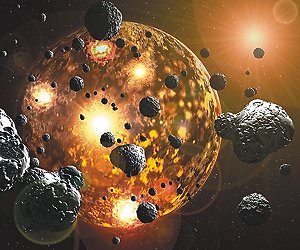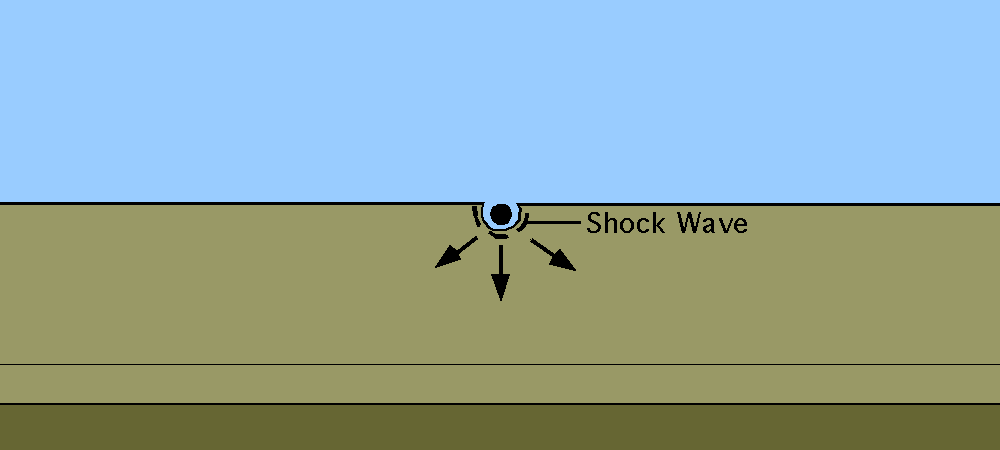Early Earth was a wild and wooly place. In its first billion years, during a period called the Archean, our planet was still hot from its formation. Essentially, the surface was lava for millions of years. Asteroids bombarded the planet, and the place was still recovering from the impact that formed the Moon. Oceans were beginning to form as the surface solidified and water outgassed from the rock. The earliest atmosphere was actually rock vapor, followed quickly by the growth of a largely hot carbon dioxide and water vapor blanket. Earth was just starting land masses that later became continents. For decades, geologists have asked: what started continental formation?
It’s a topic still under debate. However, a new study out of Curtin University in Australia offers one possible explanation: ancient impacts by giant asteroids. The evidence lies in zircon crystals found in one of the oldest pieces of ancient crust on Earth. They point directly to a violent period in Earth’s early history when giant meteorites crashed to the surface, planting the seeds (as it were) of the continents that grew from eruptions spurred by the impacts.
Bombardment by Asteroid
Billions of years ago, Earth, along with the other planets, was a target for incoming asteroids. The early solar system was crawling with these chunks of rock and ice. Earth itself came together as some of those objects accreted together to make a larger world. They brought substantial amounts of minerals and water to the infant planet. During Earth’s first billion years or so, the giant impacts continued through a time called the Late Heavy Bombardment. That period ended about 3.8 billion years ago, and coincides with the formation of some of the oldest remaining rocks on the planet.
 Questions abound about the Late Heavy Bombardment. Could it have contributed the formation of continents? Image Credit: SouthWest Research Instititute
Questions abound about the Late Heavy Bombardment. Could it have contributed the formation of continents? Image Credit: SouthWest Research Instititute
Impacts and impact craters are fairly well-understood and we see evidence of impacts on solid surfaces throughout the solar system. But, Earth seems to be only place where the process spurred the creation of continents. How did that happen? Let’s look at what occurs during a giant impact.
When Objects Collide with Earth
The force of the collision affects both the atmosphere and the surface. The shock wave from the incoming impactor fractures and then melts the crust in a process called “shallow melting”. The illustration below shows that process. That creates crystals that are typical of impact melt. If there’s water nearby (as there almost certainly was on early Earth), then it would also play a role in crystal formation and altering rocks. Those processes are fairly typical of the aftermath of giant impacts during the first billion years of Earth’s history. If the impact is big enough, it could deliver enough punch to trigger mantle melting. The mantle is the layer just below Earth’s crust. In such an impact, lava would pour out through the fractured crust. Impacts also throw out spherules of melted material out to great distances across the surface.
 An animation modelling the impact, and subsequent crater formation of the Chicxulub impact 65 million years ago (University of Arizona, Space Imagery Center). Ancient impacts like this one, but billions of years ago, could have contributed to the formation of continents.
An animation modelling the impact, and subsequent crater formation of the Chicxulub impact 65 million years ago (University of Arizona, Space Imagery Center). Ancient impacts like this one, but billions of years ago, could have contributed to the formation of continents.
The results of the collisions create a so-called “impact structure”. If geologists find evidence of those structures in the geologic record, as they are doing in Australia, they have a “smoking crater” of evidence. It points toward impact involvement in the creation of what they refer to as a “continental nucleus” at the impact point. In addition, by studying the crystalline content of the rocks in the structure and in surrounding regions, they can also see the results of a process called “crustal differentiation”. And that began with the formation of the earliest landmasses, from the seeds planted by giant impacts. At least, that’s the idea.
Now, of course, it probably wasn’t the case that asteroids dropped themselves onto the surface and instant continents formed. It had to be a longer, more drawn-out process where the impacts provided the impetus (or the seed structures) that led to the creation of continental structures.
How Did Asteroids Form Continents?
The Curtin study, led by Dr. Tim Johnson, supports that idea. Now, it isn’t a new one, but it really needed to be proved by physical evidence. Given that much of Earth’s surface has changed since the Late Heavy Bombardment through erosion and inundation, the team had to look for really old rock samples dating back to that period. That’s why they went to the Pilbara Craton. It’s a pristine example of rock formed by geologic processes and shows evidence of impact-related structures and minerals created during collisions during the Late Heavy Bombardment. Those structures could well be part of the continent-forming process.
“By examining tiny crystals of the mineral zircon in rocks from the Pilbara Craton in Western Australia, which represents Earth’s best-preserved remnant of ancient crust, we found evidence of these giant meteorite impacts,” Johnson said. “Studying the composition of oxygen isotopes in these zircon crystals revealed a ‘top-down’ process starting with the melting of rocks near the surface and progressing deeper, consistent with the geological effect of giant meteorite impacts.”
This study of zircon crystals and other minerals is the first solid evidence pointing toward the impact-related evolution of Earth’s continents. The study of Pilbara Craton is just the first step in understanding the role of impacts in continental formation. “Data related to other areas of ancient continental crust on Earth appears to show patterns similar to those recognised in Western Australia,” said Johnson. “We would like to test our findings on these ancient rocks to see if, as we suspect, our model is more widely applicable.”
For More Information
Giant impacts and the origin and evolution of continents
Assembling Australia

